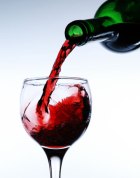 18 February is National Drink Wine Day, the purpose of which is “to spread the love and health benefits of wine”. (The nation in the national is the US but there’s no reason, surely, why the UK couldn’t adopt such a worthy holiday?) Appropriately, if somewhat gruesomely, on this day in 1478 George Plantagenet, 1st Duke of Clarence was drowned in a butt of Malmsey – in today’s terms, about 480 litres of sweet Madeira wine. (And it happened at the Tower of London, so there is a London connection.)
18 February is National Drink Wine Day, the purpose of which is “to spread the love and health benefits of wine”. (The nation in the national is the US but there’s no reason, surely, why the UK couldn’t adopt such a worthy holiday?) Appropriately, if somewhat gruesomely, on this day in 1478 George Plantagenet, 1st Duke of Clarence was drowned in a butt of Malmsey – in today’s terms, about 480 litres of sweet Madeira wine. (And it happened at the Tower of London, so there is a London connection.)
 On this day in 1678, John Bunyan’s Christian allegory The Pilgrim’s Progress or, more properly, The Pilgrim’s Progress from This World to That Which Is to Come; Delivered under the Similitude of a Dream, was published. Bunyan died in 1688, at the sign of the Star, a shop in Snow Hill run by his grocer friend Mr Strudwick.
On this day in 1678, John Bunyan’s Christian allegory The Pilgrim’s Progress or, more properly, The Pilgrim’s Progress from This World to That Which Is to Come; Delivered under the Similitude of a Dream, was published. Bunyan died in 1688, at the sign of the Star, a shop in Snow Hill run by his grocer friend Mr Strudwick.
Meteorological conditions have nothing to do with this name Snow Hill, which has been described as “a mysterious name of unknown origin”. It was once known as ‘Snore Hylle’ (as early as the reign of Henry III) and therein lies more than one tale.
Snore could have come from a Scandinavian trader called Snorro who lived there. It could also have come from the Celtin word ‘snuadh’, a brook, because the hill once led to the Fleet River. Or it could be that, because Snow Hill is steep and winding, the name derives from an old word meaning ‘twist’.

Once again, there is another theory that, while unlikely, is much more fun. The Saracen’s Head inn at Snow Hill was a coaching inn dating back to the time of Richard the Lionheart (who stopped there when he came back from the Crusades and gave the landlord permission so to name it). Passengers arriving at the tavern after travelling a long way would generally, by then, be sound asleep and snoring, giving rise to the hill’s earlier name.
In John Stow’s time, it was a “fair and large inn for the receipt of travellers”, but it was demolished in 1868.
The steepness of the hill made it ideal for one particular, non-commendable, 18th-century pastime. Groups of young men (called Mohocks, from the Mowhawk Indians) would seize elderly women, put them in tubs or barrels, and roll them to the bottom of the hill. They would also upend coaches onto rubbish heaps (presumably whether or not there were any elderly women inside them).
At one point, in 1715, it was not a good place to pass if you were not a Jacobite supporter: a group of Jacobites congregated at the bottom of the hill, toasting the memory of James. If any passers-by were foolish enough to decline to join in the toast, they were stripped.
And, lest you think we have given up on the wine theme: Snow Hill historically was the site of one of the City of London conduits and on days of great celebration it was made to run with red and white wine. Sadly, this tradition is no longer upheld.


2 responses to “Wine, Mohawks, and snow”
[…] Richard did make contributions to London street names, one of which was Snow Hill. He also, with great foresight, given the fires that raged through London in later centuries, […]
[…] to form a head of water, which was then conveyed by a lead pipe around 2,000 yards long to Snow Hill where a derelict conduit was […]